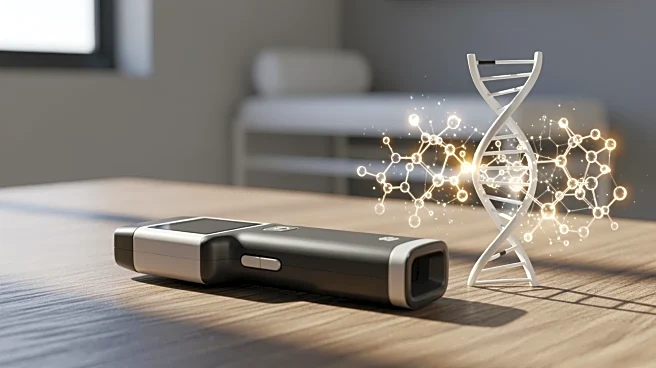What's Happening?
A new handheld device has been developed to detect tuberculosis (TB) using CRISPR technology, specifically targeting urinary lipoarabinomannan (LAM). This device integrates an assay operation module and a power
control module, enabling real-time sample-to-answer detection. The device addresses the limitations of traditional PCR methods, which require specialized equipment and incur high costs, making them less accessible in resource-limited settings. The device has undergone testing to evaluate interference from various substances and drugs, demonstrating its potential effectiveness in diverse environments. The assay employs magnetic force-based enrichment and a colorimetric signal-transducing method to enhance sensitivity and cost-effectiveness, eliminating the need for bulky instrumentation. The device's design allows for the sequential transportation of samples and reagents, facilitating efficient detection of TB in patients who cannot produce sputum, such as those coinfected with HIV and M.tb, individuals with extrapulmonary tuberculosis, or pediatric TB cases.
Why It's Important?
The development of this handheld device is significant as it offers a cost-effective and accessible solution for TB detection, particularly in resource-limited settings. Traditional PCR methods, while effective, are often too expensive and require specialized equipment, limiting their use in low-income regions. By providing a portable and efficient means of detecting TB, this device could improve diagnostic capabilities in areas with limited healthcare infrastructure. This advancement could lead to earlier detection and treatment of TB, reducing transmission rates and improving patient outcomes. The device's ability to function without the need for bulky equipment makes it particularly valuable in remote or underserved areas, where healthcare resources are scarce. Additionally, the device's design allows for the detection of TB in patients who cannot produce sputum, broadening its applicability and potentially increasing the number of individuals who can be accurately diagnosed.
What's Next?
Further clinical validation and testing are likely necessary to ensure the device's reliability and effectiveness in various settings. The device may undergo additional trials to assess its performance in real-world conditions, including its ability to detect TB in diverse patient populations. Stakeholders such as healthcare providers, policymakers, and non-governmental organizations may explore opportunities to implement this technology in regions with high TB prevalence. The device's affordability and portability could make it an attractive option for global health initiatives aimed at reducing TB incidence. As the device gains recognition, partnerships with healthcare systems and organizations could facilitate its distribution and integration into existing diagnostic protocols. Continued research and development may focus on enhancing the device's sensitivity and specificity, ensuring it meets international standards for TB detection.
Beyond the Headlines
The introduction of this handheld device could have broader implications for the field of diagnostic technology, potentially paving the way for similar innovations targeting other infectious diseases. The use of CRISPR technology in point-of-care diagnostics represents a shift towards more personalized and precise medical interventions. Ethical considerations may arise regarding the accessibility and distribution of such technologies, particularly in regions with varying levels of healthcare infrastructure. The device's ability to function in resource-limited settings highlights the importance of developing technologies that address global health disparities. Long-term, this innovation could contribute to the democratization of healthcare, providing more equitable access to diagnostic tools and improving health outcomes across diverse populations.












